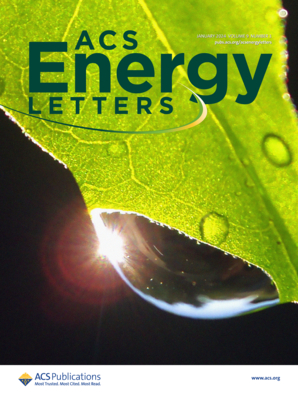Unlocking Brightness in CsPbCl3 Perovskite Nanocrystals: Screening Ligands and Metal Halides for Effective Deep Trap Passivation
IF 19.3
1区 材料科学
Q1 CHEMISTRY, PHYSICAL
引用次数: 0
Abstract
Despite the significant advances made in achieving green (CsPbBr3)- and red (CsPbI3)-emitting halide perovskite nanocrystals (NCs) with high quantum yields and colloidal stability through surface engineering, obtaining bright violet/blue-emitting CsPbCl3 NCs with long-term stability is still a grand challenge due to their defect sensitivity. In this work, we have screened the surface passivation of CsPbCl3 NCs using ligands with different functional groups (amine, sulfonic, and phosphonic acid) and metal halides (mono- and bivalent) with the aim of improving the emission yield and stability of CsPbCl3 NCs. This enabled us to find that phosphonic acids are the ligands that showed the highest efficiency as they occupy Cl vacancies and covalently bind to the Pb on the surface of NCs, together with the incorporation of bivalent metal chlorides that showed substantial enhancements in PLQY. Consequently, the most effective passivators were those that passivate Cl vacancies, indicating these to be among the most detrimental traps. This is further validated through Density Functional Theory (DFT), suggesting that the trend in adsorption energies is as follows: hexylphosphonic < hexylsulfonic < oleylamine < tetrabutyl ammonium, which is also coherent with the charge transfer mechanism and corresponding electronic structure of the halide perovskite surface with the ligands. Furthermore, after evaluating different passivation strategies, we identified in situ passivation as the most effective method for obtaining highly luminescent CsPbCl3 NCs that exhibit stability for over 6 months. Thus, this work is expected to guide the perovskite NC researchers to choose effective passivating agents and passivation strategies toward bright blue luminescent colloidal halide perovskites and beyond.

求助全文
约1分钟内获得全文
求助全文
来源期刊

ACS Energy Letters
Energy-Renewable Energy, Sustainability and the Environment
CiteScore
31.20
自引率
5.00%
发文量
469
审稿时长
1 months
期刊介绍:
ACS Energy Letters is a monthly journal that publishes papers reporting new scientific advances in energy research. The journal focuses on topics that are of interest to scientists working in the fundamental and applied sciences. Rapid publication is a central criterion for acceptance, and the journal is known for its quick publication times, with an average of 4-6 weeks from submission to web publication in As Soon As Publishable format.
ACS Energy Letters is ranked as the number one journal in the Web of Science Electrochemistry category. It also ranks within the top 10 journals for Physical Chemistry, Energy & Fuels, and Nanoscience & Nanotechnology.
The journal offers several types of articles, including Letters, Energy Express, Perspectives, Reviews, Editorials, Viewpoints and Energy Focus. Additionally, authors have the option to submit videos that summarize or support the information presented in a Perspective or Review article, which can be highlighted on the journal's website. ACS Energy Letters is abstracted and indexed in Chemical Abstracts Service/SciFinder, EBSCO-summon, PubMed, Web of Science, Scopus and Portico.
 求助内容:
求助内容: 应助结果提醒方式:
应助结果提醒方式:


